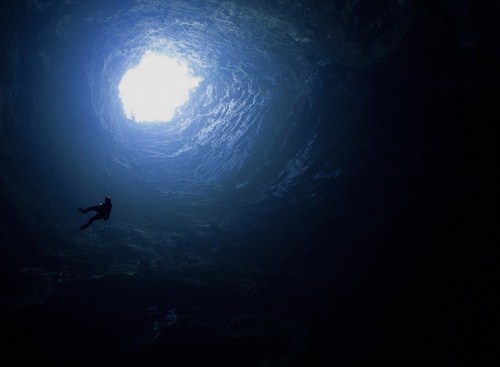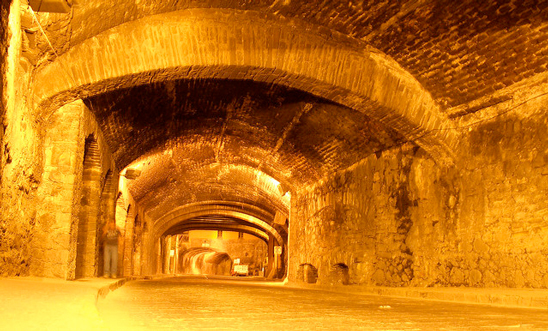Mexico, "Place at the Center of the Moon"
 •
by
•
by lviz Fer

Hello everybody, as the wonderful article of Corol (Here is the link to his article) I want to show the most beautiful, from my point of view, places of Mexico.
Mexico is one of the most important tourist destination all around the world, because of its incredible biodiversity, its wonderful nature beauty, its great history, the unforgettable tequila and the irreplaceable mariachi.
Let’s start.
Barrancas del Cobre
The Sierra Tarahumara in the northern state of Chihuahua, give to us some of the most awesome and unusual landscapes, thanks to the set of canyons named as Barrancas del Cobre.
All over this mountains you can feel the dizziness that causes admire the depth of this cliffs that grow to more than 1800 meters high, surpassing even the Grand Canyon from Colorado.

Cosmovitral
It is the most important stained glass built on the twentieth century, one of the most important contribution to contemporary international art, and the largest stained glass in the world.
Created by master Leopoldo Flores Valdes, this monumental required the participation of a group of nearly 100 artisans for making the structure, more than 40 tons of blow glass, 28 different colors of glass and more than 70 tons of metallic structure. The Cosmovitral addressed the “Relation between man and the universe” the cycles of life and the dualities and antagonisms of universe.
It is also a botanical garden which has about 400 species of plants, trees and bushes from the State of Mexico and the rest of world.
It is located in Toluca (where i live).

Cave of swallows
It is an imposing chasm, with a deep of 512 meters, it looks like the mouth of a giant who seeks to devour the world.
Each morning, flocks of birds exit the cave by flying in circles, gaining height until they reach the opening and the sky. In the evenings a large flock of swifts circle the mouth of the cave and about once each minute, a group of perhaps fifty breaks off and heads straight down towards the opening. When they cross the edge, the birds pull in their wings and free-fall, extending their wings and pulling out of the dive when they reach the heights of their nests.
A person without a parachute would take almost ten seconds to freefall from the mouth to the floor, hence the pit is also popular with extreme sports enthusiasts for base jumping.

Palacio de Bellas Artes
The Palace of Fine Arts is the most important cultural center in Mexico City. It is located on the west side of the historic center of Mexico City next to the Alameda Central park.
The palace has a mixture of a number of architectural styles; however, it is principally Art Nouveau and Art Deco. Art Nouveau dominates the exterior, which was done by Adamo Boari, and the inside is dominated by Art Deco, which was completed by Federico Mariscal. Since construction began in 1904, the theater (which opened in 1934) has sunk some four meters into the soft soil of Mexico City. The main facade, which faces Avenida Juárez, is made of white Italian Carrera marble. In the interior of the portal are sculptures by Italian Leonardo Bistolfi. It consists of "Harmony", surrounded by "Pain", "Rage", "Happiness", "Peace" and "Love". Another portion of the facade contains cherubs and sculptures representing music and inspiration.
The Palace has been the scene of some of the most notable events in music, dance, theatre, opera and literature and has hosted important exhibitions of painting, sculpture and photography. It has hosted some of the biggest names from both Mexico and abroad.

Cenotes Xkeken and Samulha
The Yucatan Peninsula is known for its many cenotes. These underground freshwater reservoirs, were sites of great ceremonial importance to the ancient Maya.
Today its enigmatic beauty can be appreciated fully in two of the most spectacular cenotes of the region, Samulha and Xkeken, both located a few kilometers from the city Valladolid of Yucatan.
Cenotes have attracted cave divers and there are organized efforts to explore and map these underwater systems. The Quintana Roo Speleological Survey maintains a list of the longest and deepest water filled and dry caves within the state boundaries.

Underground streets of Guanajuato
This streets were rivers, with over 8 miles of tunnels, making it the world's largest underground. Scenario of romance, inspiration, culture and tradition, architectural symphony written by architects from Guanajuato. The tunnels of Guanajuato, walls witness of history, give life to one of the most beautiful and magical cities in the world, which is World Heritage and home of The Festival Internacional Cervantino.
The underground city streets of Guanajuato are, without doubt, one of the most unusual attractions there. Below commun streets are these particular streets that were built to rid the city of the multiple floods suffered in another time. True arteries that cross the city completely and currently are the way sought by hundreds of cars.

Prismas basálticos
It is the result of slow cooling lava millions of years ago. In this way were formed columns of 5 or 6 sides, some vertical and others horizontal. These basalt columns decorate the walls of the canyon Alcholoya, this canyon has four waterfalls with a high of approximately 40 meters high.
Around the basaltic prisms was created a resort, with camping areas, grills, restaurants, swimming pools, sports courts and crafts shops. In addition, horse riding and boat tours are organized near the San Antonio dam.

Here are few honorable mentions
Cañon del Sumidero

Tajin

Chichen Itza

Teotihuacan

El Cielo

Nevado de Toluca

This are from my point of view some of the most beautiful places in Mexico, I hope you enjoy it and see you soon.
Matthew Arnold


Comments
Don't forget the border!
I see what you did there. 😁)
i see too.
Everyone saw that xD
Awesome work lviz Fer.
Thank you so much for your entry. Swiss articles are getting more and more classy!
pozzzzzzzzzz
:') Mis bellos prismas.
Es que son hermosos 😃
v
o7
wowww,,,is that Mexico panoramas? have any Pyramids too at there?
Buenisimo !!
Solo Mexico es bello!!
saludos
Solidar Komentariu
Thank you 😃
Cool article and great pics!
COMMENT COMMENT COMMENT C
OMMENT COMMENT COMMENT CO
MMENT COMMENT COMMENT COM
MENT COMMENT COMMENT COMM
ENT COMMENT COMMENT COMME
NT COMMENT COMMENT COMMEN
T COMMENT COMMENT COMMENT
There are some comments for you. 😃
Just what I need xD, thank you 😃
comment
commented
o7
Great!! ;o)
Beautiful place .
V
o7
o7
V🙂 great pic's
Muy buen articulo, que lugares tan bellos.
Prout